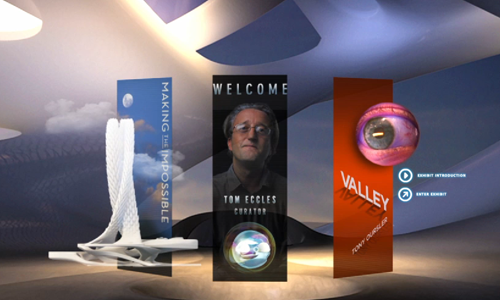I went to take a look at the Adobe Museum mentioned in the class. The concept of a virtual museum is really fresh.
 |
| Adobe Museum of Digital Media |
The aesthetic of the museum really caught my eyes. Since there is no limitation in designing a virtual reality dwelling, the designers are able to bring to life all kinds of awe-inspiring structures and layouts. The entire museum feels like it's from a science fiction book, with the towering architecture and hologram prompters. I especially enjoyed watching the jellyfish/eyeball "tour guide" implemented by the designers. They really brought the entire museum experience to life by creating something that I feel like I am interacting with/having a conversation with.
 |
| Eyeball-like floating devices that guides the user through the museum. |
However, aside from what it has to offer as an unique sci-fi exploration, I didn't really find the whole "virtual museum" concept believable. The navigation option offered is very linear, even though the designers attempted to re-create the way how museum-goers usually traverse through exhibits. I'm prompted with clickable "icons" to decide where to go, and that just makes me feel as if I'm looking through any ordinary web page. It might have helped if instead of opting for the clicking mechanism, the museum allows people to navigate through it by re-orienting itself depending on the location of the mouse (i.e. moving the mouse to the left means turning leftward, right is rightward, up is forward, and down is backward). At least the movement of the mouse mimics real life actions.
 |
| Main navigation "page", where the user can select which exhibit to view and what information to look up. |
The exhibit I saw is tailored especially for this virtual museum, so it relied very heavily on visual animation and sound. But because the visuals are limited to my screen (thus under the mercy of my computer's graphic card ability), and the audio is at best stereo headphone sound, my entire experience feels flat. If the same exhibit was moved to an actual museum room, then other ambient factors such as echo, vibration, reflection, etc will all have played extremely important roles in how I interpret the artwork.
In the recent tour we went to the Davis museum, I was very impressed by the whale room piece in the Calculated Risk exhibit. That piece utilized the entire room to present itself to the viewer. I was able to move around and observe the entire whale and harpoon components from different angles, and under different lighting. However, this is not possible in the Adobe virtual museum. So I find the virtual museum experience very limiting, and it feels like a cheap rip-off of the real museum experience.



No comments:
Post a Comment